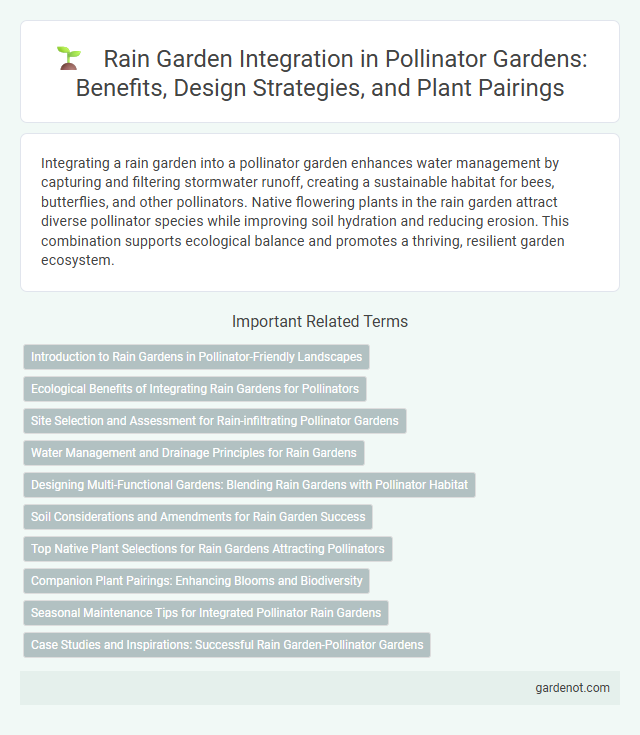Integrating a rain garden into a pollinator garden enhances water management by capturing and filtering stormwater runoff, creating a sustainable habitat for bees, butterflies, and other pollinators. Native flowering plants in the rain garden attract diverse pollinator species while improving soil hydration and reducing erosion. This combination supports ecological balance and promotes a thriving, resilient garden ecosystem.
Introduction to Rain Gardens in Pollinator-Friendly Landscapes
Rain gardens enhance pollinator-friendly landscapes by capturing and filtering stormwater runoff, reducing pollutants and providing essential habitat for pollinators like bees and butterflies. These gardens use native plants and deep-rooted species that thrive in moist conditions, creating a diverse ecosystem that supports nectar and pollen sources. Integrating rain gardens promotes biodiversity, conserves water, and improves soil health, contributing to sustainable pollinator environments.
Ecological Benefits of Integrating Rain Gardens for Pollinators
Integrating rain gardens into pollinator habitats enhances water filtration, reduces runoff, and creates moist microhabitats essential for diverse pollinator species like bees and butterflies. These rain gardens support native flowering plants that provide nectar and pollen, improving biodiversity and sustaining pollinator populations. By mitigating urban heat and erosion, rain gardens foster resilient ecosystems that bolster pollinator health and ecosystem services.
Site Selection and Assessment for Rain-infiltrating Pollinator Gardens
Selecting a rain garden site for pollinator habitats requires assessing soil infiltration rates, existing vegetation, and slope to ensure effective rainwater capture and minimize erosion. Optimal locations include gently sloped areas away from large tree roots that can compete for moisture and nutrients. Soil testing for permeability and contamination is essential to support both healthy plant growth and efficient water infiltration.
Water Management and Drainage Principles for Rain Gardens
Rain garden integration in pollinator gardens enhances water management by capturing and filtering stormwater runoff, reducing erosion and nutrient pollution. Utilizing native plants with deep root systems promotes effective drainage, allowing water to infiltrate the soil gradually while supporting pollinator habitats. Proper grading and soil composition ensure optimal retention and percolation, preventing waterlogging and maintaining healthy garden ecosystems.
Designing Multi-Functional Gardens: Blending Rain Gardens with Pollinator Habitat
Rain gardens integrated with pollinator habitats enhance biodiversity by providing essential water filtration and nectar sources in a single landscape feature. Utilizing native plants such as milkweed, goldenrod, and coneflowers supports pollinators like bees, butterflies, and hummingbirds while managing stormwater runoff effectively. This multi-functional design improves ecosystem resilience and promotes sustainable urban green spaces.
Soil Considerations and Amendments for Rain Garden Success
Soil considerations are crucial for rain garden success, emphasizing well-draining, loamy soil with balanced sand, silt, and clay proportions. Incorporating organic amendments such as compost or aged manure enhances soil structure, moisture retention, and nutrient availability vital for pollinator-friendly plants. Testing soil pH and adjusting to a slightly acidic to neutral range (6.0-7.0) ensures optimal plant growth and supports diverse pollinator species.
Top Native Plant Selections for Rain Gardens Attracting Pollinators
Top native plant selections for rain gardens attracting pollinators include Asclepias tuberosa (butterfly weed), Monarda fistulosa (wild bergamot), and Echinacea purpurea (purple coneflower), all known for their nectar-rich blooms that support bees, butterflies, and hummingbirds. These species thrive in both wet and dry conditions, making them ideal for rain garden integration by improving water absorption and soil health. Incorporating native plants like Solidago spp. (goldenrod) and Lobelia cardinalis (cardinal flower) ensures a diverse, pollinator-friendly habitat that enhances ecosystem sustainability and biodiversity.
Companion Plant Pairings: Enhancing Blooms and Biodiversity
Rain garden integration with pollinator gardens boosts bloom vitality and supports biodiversity through strategic companion plant pairings. Selecting native wildflowers like milkweed alongside water-loving sedges and rushes ensures moisture retention and attracts diverse pollinators such as bees, butterflies, and hummingbirds. This synergy enhances ecological resilience while creating visually stunning floral displays that thrive in variable rain garden conditions.
Seasonal Maintenance Tips for Integrated Pollinator Rain Gardens
In integrated pollinator rain gardens, seasonal maintenance ensures optimal plant health and water absorption capacity. Spring requires debris removal and mulching to promote native flowering plants that attract pollinators, while summer demands regular monitoring for invasive species and irrigation during dry spells. Fall involves cutting back perennials and adding compost to sustain soil fertility, supporting a thriving habitat for pollinators year-round.
Case Studies and Inspirations: Successful Rain Garden-Pollinator Gardens
Successful rain garden-pollinator garden integrations demonstrate increased biodiversity and improved stormwater management, as shown in case studies from urban parks in Portland and Minneapolis. These projects highlight the use of native plants like Echinacea and Asclepias, which support pollinators while absorbing runoff efficiently. Designs inspired by these models balance habitat creation with ecological functionality, fostering resilient landscapes in both residential and public spaces.
Rain garden integration Infographic

 gardenot.com
gardenot.com